 Leading Blog | Posts by Month |
 Leading Blog | Posts by Month |
03.31.19

LeadershipNow 140: March 2019 Compilation
See more on  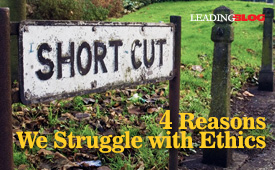
Posted by Michael McKinney at 04:24 PM
03.29.19

Do Ethics Really Make You a Better Leader in Business?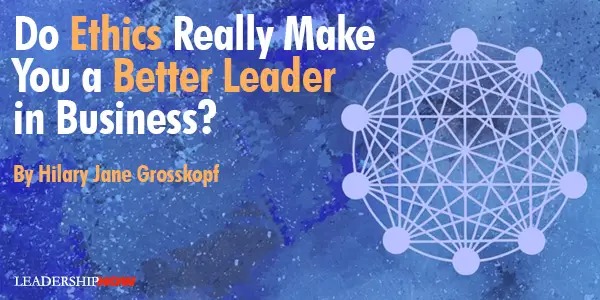
ETHICS IS NOT a word used very often behind the walls of companies and organizations. Many companies have a set of values and company policies. However, very few companies educate leaders about ethics and encourage leaders to discuss ethics with their teams. Ethics are usually an afterthought, taken seriously only after an event that causes a business or team to fall apart. If understood and put into practice by a dedicated leader, ethics have the potential to turn stagnant, declining teams into productive and engaged ones. Ethics enable new teams to continue to grow, sustain, and thrive as the individuals and the business evolve. Ethics are the foundation for peace and progress. Don’t we all crave both peace and progress at work? Ethics are timeless principles for behavior toward ourselves and others that translate to specific actions. Ethics are what fuel personal growth and make large-scale collaborative efforts work. The lack of clarity about what ethics are and what ethics really involve in action is the primary barrier for many leaders in practicing ethics at work. Here is how an understanding and intentional practice of ethics at work make leaders, and therefore businesses, stronger and more successful. Truthfulness over time opens and repairs communication lines. Ethics prize the principle of truthfulness. Though it seems straightforward, it often takes courage to truly be truthful with team members and peers. Leaders that practice truthfulness with team members build genuine trust over time. Leaders that practice truthful, transparent communication build a team culture of interpersonal respect and alignment. A practice for cultivating trust is to have regular one-on-one meetings with team members. In your one-on-one meetings, leave technology and distractions behind. Give your team members dedicated focus, ask if they have questions, and give them positive and constructive feedback. Leaders develop trust through transparent and genuine communication. Teams united in honesty and truthful communications move forward as a cohesive unit. Opportunities for individual development fuel collective progress. Leaders that understand and practice ethics at work are also better at motivating and empowering individuals in order to fuel collective progress. Another foundational ethical principle is the concept of non-stealing. In workplaces, non-stealing goes far beyond just stealing of physical possessions. Non-stealing in leadership involves not stealing (but instead giving) opportunities, knowledge, and acknowledgment to team members. Leaders can practice the ethical practice of non-stealing by giving knowledge, skills, and opportunities to team members enable progress. In one-on-one meetings, share your skills and knowledge with team members. Mentor them as they work through a special project or assignment on their own. When individuals are given opportunities to grow individually, they are more dedicated and skilled contributors. Leaders that practice non-stealing understand that individual peace and progress must happen for each team member in order for the whole to move forward. Non-attachment enables creative problem solving and the generation of new ideas. Leaders often find themselves stuck, leading a stagnant team because they are attached to their ways or outdated beliefs. Beliefs about what is right or beliefs about people’s limitations often hold back the team from progressing. Leaders who are not open to new ideas and feedback compromise the collective progress of the team. Non-attachment is practiced by letting go of your outdated beliefs about people, ways, results, or status. New ideas and suggestions that team members bring to the table are often the answers to proactively solving or avoiding problems. Don’t hold firm beliefs about the way things should be, how far someone should progress, or the exact way results should turn out. Allow space for limitless possibility and evolution to happen. Invite and evaluate new ideas and suggestions with an open mind. This practice enables collective progress. Positive communication and mindfulness foster focus and protect valuable energy. Finally, ethical leaders are masters of cultivating the conditions for collaboration. In dynamic, fast-paced business environments, leaders and teams often find themselves rushing and producing work full of errors. People burn out quickly after long days of exhausting meetings. Small disagreements or misalignments turn into political issues. Arguments deter focus and negatively impact productivity and engagement. Ethical leaders know how to practice control of energy in order to cultivate focus and ease for their team. Control of energy involves communicating with a positive tone. Even when giving constructive feedback, ethical leaders start with a positive affirmation and use a tone of equanimity throughout the conversation. This is a sustainable rather than a short-sighted approach. This control of energy helps to cultivate calm and protect the energy of the team and themselves. Control of energy also involves taking constructive rest breaks often to restore and rejuvenate. A walk outside, away from the screen and often chaotic work environment can do wonders to reset your mind and body. Lead by example and encourage your team members to do the same. Ethics are the foundation for strong leadership and collaboration. When understood and put into practice at work, ethics have the potential to fuel productivity and motivation. Ethical leaders cultivate focus, trust, and connection, which are key ingredients for successful leadership. Leaders that practice ethics in action find that the principles reach far beyond company walls and add value to their lives outside of work as well. Ethics are universal and add value to our work and life. How can you put ethics into practice to strengthen your leadership? Many leaders don’t realize that diverse teams often have very different individual perceptions of what ethics look like in practice. Teams need to learn a collective language for ethics in order for ethics to be accessible instead of vague. Leaders can lead by example by putting ethics into action by learning the ten principles from the Awake Ethics guidebook, doing the individual and team exercises for putting the principles into practice, and reflecting on how the actions of the individuals align with their core intentions of peace and progress. 
Posted by Michael McKinney at 12:44 PM
03.27.19

Fail More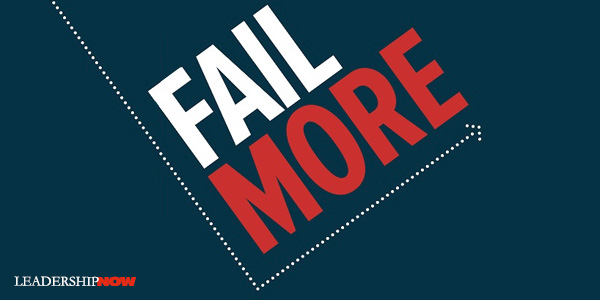
EVERYTHING YOU DO involves risk. The only questions are what and how much. Poor choices lead you into failure, and good choices take you out of failure. “Success and failure both leave room for improvement. Inside every success, there are remnants of failure, and in every failure, there are pockets of success” writes Bill Wooditch in Fail More. He wrote the book not to encourage irresponsibility or to give license to “intentionally flunk life one mistake at a time,” but rather to continually improving through intentional practice, with the willingness to embrace the process, and the ability to learn from the result. Nobody likes failure. We are lead to believe that failure means that there is something wrong with us. Failure simply represents a challenge; not something to avoid. “If you try to evade the things that are fundamentally important to your growth, you’ll pay the price of your neglect at a later date.” Perfect isn’t part of the human condition. Many people wait for “perfect” before they begin, but perfect isn’t just going to show up out of nowhere. We all have to do the gritty and unglamorous work if we’re going to push the envelope. You have to put your toes on the edge of “comfortable” and step into the pain of change and the cloud of uncertainty to make a real difference in your life. We crave certainty, and that feeds our fears. When it gets uncomfortable, when fear sets in, “you can’t get emotional; you have to stay centered in logic and break things down to small wins every day.” That’s how you overcome obstacles. “When you move from emotion (fear) to logic (obstacle management), you can then visualize an outcome by walking through the imaginary steps it takes to achieve it.” The lesson of Fail More is to keep going. “Rejection will slap you in the face, not once, not twice, but so many times that you’ll lose count. But your purpose will compel you to keep going, adapt, and grow.” There is a lot of material out there reminding us to embrace failure and clever memes that point you forward, but Wooditch makes one of the best presentations of the subject I’ve ever read. There are the stories of Jack Ma, Mark Cuban, Steve Harvey, Sara Blakely, J.K. Rowling, David Neeleman, and other well-known and not so well-known individuals, but he includes his own experiences that give it depth and credibility. Fail More will help you to work past your fears, the obstacles, set realistic goals, and learn from every result. Success is a process, and failure is part of that process. Failure gives you the critical feedback you need to make the necessary adjustments to bring you closer to your goal. Keep in mind:
Here are several more takeaways: There is an expected range of failure that is the price of “good.” Learn to be okay with it. Failing more is trying more. The greatest point of growth occurs right below your limit. Be one of those people that works right up to their edge of comfort. We all start at a place where we need to improve if we are going to succeed on a more significant scale. When you seek out uncertainty, you are opening your mind to possibility. Procrastination, lack of prioritization, and the absence of goals all have their origins in fear. In order to get what you want, you have to do those things that give you the confidence to do just a little bit more the next day. 
Posted by Michael McKinney at 05:54 PM
03.25.19

Are You Living in Conflict Debt?
WHEN YOU AVOID the tough discussions and decisions, you hold your business back, make your team dysfunctional, and cause yourself stress. You set up a kind of conflict debt. Conflict debt, writes Liane Davey in The Good Fight, “is the sum of all the contentious issues that need to be addressed to be able to move forward but instead remain undiscussed and unresolved.” The solution is more conflict, not less. “Rather than working through the conflicts that will help our organizations move forward, we avoid, postpone, evade, duck, dodge, and defer them.” We need to work through our contentious issues. Most of us are conflict adverse—as is the author—and she explains why we are that way. We have been conditioned to get along, but we often take that to mean that we should avoid all conflict or simply accommodate others. But she concludes, “conflict is a natural part of healthy relationships and a critical defense against unhealthy ones.” Conflict is normal. And we either can either make it better or worse. And that doesn’t happen by assuming we are right. We need to be curious about the other person or people and where they are coming from. After building the case for conflict, Davey turns here attention to avoiding unnecessary conflict and establishing the ground rules for productive conflict. She calls this the Conflict Code. To begin, you need to establish a line of communication. That is, build the trust before you need it. Next, create a connection so that you can problem-solve as allies rather than fight as adversaries. “When a discussion gets heated, the facts and information presented provide excellent clues about what is important to the players. Pay attention to what is (and isn’t) said to zero in on what’s at stake. Finally, if you have completed the first two steps, you are in a good position to contribute to a solution. She offers six techniques to help you contribute a solution without bulldozing the others at the table. In part 3, Davey focuses on “what you can do to systematize conflict so it’s a part of the standard operating procedure of your team.” This section is worth the price of the book alone. Her examples resonate as they seem to be so much a part of everyday team dynamics. Clarify Expectations Clarifying roles and setting clear expectations from the beginning avoids a lot of unpleasant conflict and drama. “If everyone is clear on their role and the value they are expected to add, they will be less likely to disappoint, or be disappointed by, others in the group.” To this end she has created the U Tool. The U Tool documents “what you need from your superiors, what your team will add, and what you expect from the layers below you” and “when that value should be added.” She covers issues that the U Tool can help to neutralize like the absentee boss and micromanaging. It also helps to raise the bar on expectations. This situation is something I see in my work as an advisor: Adding value at the wrong level can create considerable conflict in your team. First, when you neglect the strategic issues, you fail to provide the direction and context that your team needs from you. In this case, you become the absentee boss and set your team up to fail. The other issue is that as you dip down into issues and choices that should be made in the next level, you disempower the leaders whose job it is to be making those decisions. It’s demoralizing when you do their job as it robs them of their opportunity to add value. I’ve even seen leaders more than two layers above encroaching on the work of the individual contributors. One of my clients admitted sheepishly that he had been “belly-down in the bottom of the U.” He was simultaneously disempowering two layers of his team. Normalize Tension When we think about teams we think about conflict-free members all rowing in the same direction. This ignores he reality and our ability to deal with it—if we do. “You can be a good team player and still create tension with your teammates.” Davey introduces a metaphor called The Tarp. Imagine a group of people stretching out a tarp and each pulling in a different direction. If it’s all in balance it works. But what happens if one team member pulls harder than the others What if the strength of one member overwhelms that of his teammates? What if one of the team members gets fed up, rolls her eyes, and walks away? To get the best possible answer out of a team, you need to pull in different directions, always optimizing the tension on the system—never pulling so hard that you take the team of course, and never so gently that your angle isn’t covered. That’s what productive tensions should feel like. The common issues are when a team member is pulling too hard dominating the discussion. Or the opposite when someone is under contributing by staying silent or gives up presenting their point of view. The Conflict Habit Make productive conflict a habit. A habit you “engage in routinely without requiring significant attention and effort.” To add productive conflict into your organization, you might begin by clarifying expectations, add then adding some low-intensity conflict by offering another perspective, define consequences, and highlight assumptions. Improve your feedback by not loading up on judgments but observations. (Very helpful section.) She also suggests using humor and code words “to draw attention to troublesome behavior in a gentler way.” Finally, encourage productive conflict in your meetings. “Instead of creating a forum for productive conflict to be surfaced and resolved, meetings are often just hour-long displays of the power and politics on your team. The actual work of discussing and coming to a solution is relegated to side conversations and he dreaded meeting-after-the-meeting.” So often we see teams living in conflict debt. They let issues pile up until someone leaves or blows up. Introducing productive conflict will take the pressure off, encourage cooperation and help you get things done. The Good Fightis a well-written book on a critical issue. The examples are helpful and it includes a bonus chapter on how this can help at home. Templates and worksheets for the U Tool and for creating a diagram of your own Tarp are available on her website. 
Posted by Michael McKinney at 08:12 AM
03.22.19

Win the Heart: The Four Cornerstones You Need to Build Engagement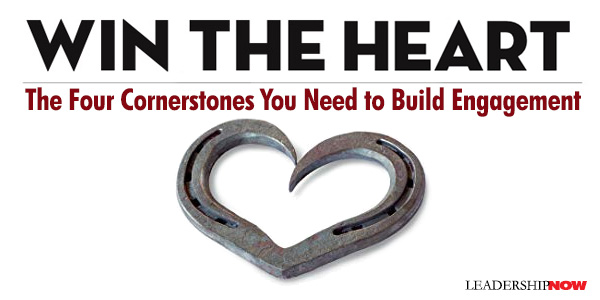
ENGAGEMENT HAS BECOME the Holy Grail of business—highly desired but hard to get. There are a number of moving parts, and it’s hard to get them all aligned. Mark Miller says that “for many organizations, engagement is the final battle to becoming a high-performance organization.” In Win the Heart, Mark Miller lays out the four cornerstones that engagement is built on. In this business fable, CEO Blake Brown senses his company has an engagement problem. He turns to an old mentor, Debbie Brewster for help. This leads him, and his wife on an international hunt for lessons concerning engagement Blake’s Dad had put together from people and places in history. Blake and his team define engagement as “a condition of the heart reflecting an individual’s level of genuine care for their work, coworkers, and the organization. And if the level of care is high enough, it will result in energy, effort, enthusiasm, and initiative” or more simply: Traveling to Selma, Alabama, Florence, Italy, Pella, Greece, Green Bay, Wisconsin, and finally, West Texas to complete the picture, they discover the four cornerstones of engagement. Connection Conversation is the primary driver. “You might even say we—me and my fellow employees—do life together. We talk about triumphs and tragedies, fears, failures, and struggles. We talk about how to help each other.” “Real conversations are the bridge to real connections.” And this includes conversations with all stakeholders. Affirmation “Their secret sauce was thank you. Loosely translated they are creating a culture of affirmation when they express genuine appreciation to their employees. They affirm people multiple times a day.” Responsibility “Leaders must be willing to actually give people responsibility! Create a culture in which sharing responsibility is the norm, not the exception. Give people real responsibility for goals, methods, and decisions, whenever it makes sense.” Environment “The how is simply to look at what people really need to win both physically and emotionally, and provide it. The coaches just equipped the team for success.” From an old friend of Blake’s Dad in West Texas, they learn that “If you just hire a man’s hands, you miss the opportunity to win his heart.” 
Posted by Michael McKinney at 10:22 AM
03.20.19

Get Savvy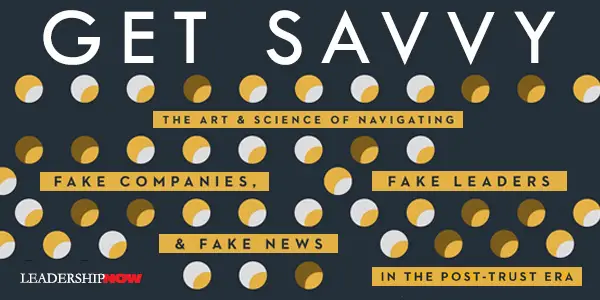
FAKE NEWS is not a new phenomenon. From the beginning of time, people have played loose with the truth in order to get what they want. Trust too, has waxed and waned over the millennia. It’s not new. People have always had to be on the lookout for fake news. And much has gotten through our filters over the centuries and has negatively impacted the assumptions we take for granted today. Perhaps what if different today is our ability to so quickly and persuasively disseminate it through technology. It makes the task of discerning fact from fiction so much harder. So much information is coming at us about things we know very little about and in our rush to form an opinion we easily become susceptible to misinformation and other people’s agendas. As Jonathan Swift wrote in 1710, “Falsehood flies and the truth comes limping after.” We believe what we want to believe. This is the subject of Savvy: Navigating Fake Companies, Fake Leaders, and Fake News in the Post-Truth Era by the husband and wife team Shiv B. Singh and Rohini Luthra. The stark reality is that we have entered ... a new post-trust era, in which telling truth from opinion, and separating fact from outright fabrications, requires us to be on guard, intensely aware of the ways in which we are being played, and how we are unwittingly contributing to the problem. Fakery has not only pervaded politics, it has made deeper inroads into business and our personal lives.  “Savvy is about understanding the role we (as consumers of information) play in succumbing to and propagating fakeness. Just as we have technology glitches so too do we have human glitches in the way we process information.” So the authors catalog some of the ways we readily deceive ourselves and play into fake news. These “glitches” are well presented and deal with the problem of fake news at its source. Repetitions Make the Truth If we hear a lie enough times, we begin to believe it. “We all know perfectly well that simply hearing something over and over again doesn’t mean it is truth, but we fall for this persuasive tactic anyway. Why?” We move toward things that are familiar to us because they are comfortable. “The more often we her something, the more familiar it becomes, and familiarity breeds trust.” We Want to Belong The desire to belong is strong. Not only does this foster groupthink, but it most often creates a toxic us versus them mentality “often leading to the demonization of the ‘other’ and contributing to discrimination and sometimes violence.” They encourage us to welcome dissenting opinions. Respect those with different viewpoints. We Want to Be Right “We want to be right, and we look for information that supports our existing beliefs.” This is known as confirmation bias. Because of this bias, when we try to convince others of the truth, they most often become more convinced of their own position. The more you try to convince someone else of your view the more entrenched they become of their own. The best approach is to find some common ground on which to build a basis for trust. Humility is in order. Overconfidence in our own opinion can cloud our judgment and lead us to marginalize others. We Bow to Authority We tend to trust people in authority. In my view, we should always respect those in authority because of our own self-respect. While respect is a choice, leaders must also know that they need to behave in a way that is deserving of respect. That said, we shouldn’t blindly follow leaders. “Assess a leader’s credibility, expertise, experience, and integrity.” We Blindly Trust Artificial Intelligence Perhaps that is an overstatement, but the authors are right in saying, “Rapidly advancing innovations are providing new capabilities that require us to give serious thought to the degree of trust we should place in the companies and governmental bodies that will be deploying them, and in the technologies themselves.” Again, it’s not the technologies, it the people who use them. Some will use them to greatly enhance the quality of our life and others will use them to control others. We need to discern the difference. And we should never blame the computer or use it as an excuse for the disrespect of human beings. Computers are programmed no matter how human they seem. 
Posted by Michael McKinney at 12:36 PM
03.18.19

How Big Companies Can (and do) Innovate Like a Start-Up
THE INNOVATION WE PRIZE at successful start-ups is a mindset that is brought into the start-up and not necessarily the inherent quality of every start-up. Innovation isn’t something that just happens; we create the conditions for it. Big organizations can innovate like small start-ups. In Creative Construction, Gary Pisano says that when big organizations fail to innovate, the root cause is often related to “management practice and leadership than with organizational scale per se.” While organizational size complicates innovation, “scale if properly exploited could actually be an advantage, not a liability, for innovation.” But here’s the thing: Simply breaking up a large organization into smaller units or creating autonomous teams is not sufficient to replicate a start-up culture. Urgency, accountability, and risk tolerance in start-ups are mindsets. Re-creating these mindsets inside an established company is challenging because they result partly from the unique pressures and circumstances under which start-ups operate. Creative Construction is the process of sustaining and rejuvenating an existing organization’s innovative capabilities. “Creative construction requires a delicate balance of exploiting existing resources and capabilities without becoming imprisoned by them.” Creative construction requires three essential leadership tasks: creating an innovation strategy, designing an innovation system, and building an innovation culture. Pisano carefully details how companies should do each of them. Creating an Innovation Strategy A good strategy helps a company clarify the tradeoffs that will be needed to make between short-term improvements and long-term opportunities. It also aligns a company around common priorities. An innovation strategy has to be based on what kind of innovation is needed. He describes four types: Routine, Disruptive, Architectural, and Radical. Each requires a different system in place to execute on it. Whatever the innovation, “the right way to judge the merits of any innovation (and innovation strategy) is value created and captured.” When faced with a potential threat of technology or business model disruption, you need to consider two things. First is the nature of the threat. How certain are you of the threat and is it imminent or distant? And second, what is the impact on your profitability. If you adopt the technology or business model, will you achieve a reasonable profit? He produced a chart that helps to clarify these opportunities.
For example, if the threat is highly likely (imminent) and the profits from it are at least as good as your current business, then jumping on the opportunity is the thing to do. He calls this scenario A New Day is Dawning. On the other hand, is the threat is imminent, but you can’t respond profitably, then The Party is Ending. In this case, you can either find new markets where you might compete or try to defend and extend the ultimate conclusion to give you time to create a better ending. The other possibilities are Intriguing Possibilities and Dark Clouds on the Horizon. In these scenarios, you are not sure the threat will materialize or if it will disrupt your profitability. “The best strategy when facing high degrees of uncertainty is to hedge and build options for the future.” Too often, innovation leadership Is posed as a test of “guts”—are you willing to make the big bets? Such “all-in” bets make for great business headlines, but they are actually pretty foolish if you face high levels of uncertainty. Making smaller bets, experimenting, learning, and adapting are survival-enhancing behaviors in highly uncertain environments. Designing the Innovation System The next essential leadership task he covers is designing a system that will give you the capability to execute on the type of innovation you need. One size does not fit all. There is no best practice. What works for Apple and Google may not work for you. Designing innovation systems begins with getting out and discovering novel problems and solutions. “Innovation in general, and the search for innovative ideas particular is an intensely human activity. What we see, what we experience, whom we listen to, whom we speak to, and whom we observe all shape our perceptions about problems worth solving and solutions worth pursuing.” Pisano says to find, develop and retain the synthesizers in your organization. Those people who are good at seeing connections across fields. Which projects should you work on and which should you kill? Build learning into your system as part of the selection process. Innovation means tradeoffs. “Every dollar that goes into exploring a new space means one less dollar for making an important refinement to a new product.” Use analytics to drive questions not answers. Building the Culture We have all heard the characteristics of an innovative culture. But leaders are not always quick to embrace them. Perhaps though, these characteristics alone are not enough. Pisano modifies each this way: Tolerance for Failure but No Tolerance for Incompetence
Willingness to Experiment but Highly Disciplined Psychologically Safe but Brutally Candid Collaborative but Individually Accountable Flat but with Strong Leadership

Posted by Michael McKinney at 08:10 PM
03.15.19

Leading Views: Entrepreneurs Are the Heroes of Creative Destruction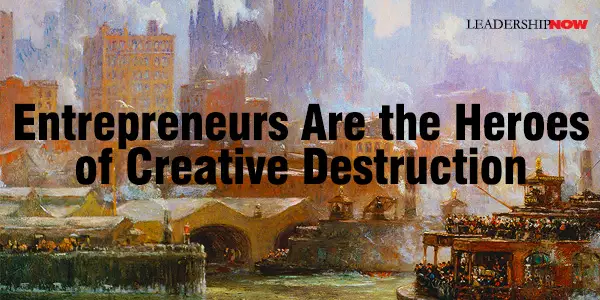
In this chronological account beginning with the American Revolution, the genius of America’s innovative success is not only its tolerance of but also its penchant for creative destruction. Though sometimes painful, it is the driving force of economic progress. The authors talk not only of the familiar product innovation but also America’s process innovation—innovation in management and organizing production. Entrepreneurs drawn from every level of society are the primary drivers of this creative destruction. Associated with openness and opportunity, America produces and draws in more entrepreneurs than anywhere else. Entrepreneurs are the heroes of creative destruction—the people with the ability to feel the future in their bones and bring it into being through sheer force of will and intellect. Entrepreneurs drive long-term growth in productivity by pursuing their dreams of building a business, launching a product, or, human nature being what it is, making a fortune. But they are seldom the easiest of heroes, or the nicest. They are almost always guilty of what might be termed imperialism of the soul: they will sacrifice anything, from their own peace of mind to the lives of those around them, to build a business empire and then protect that business empire from destruction. Great entrepreneurs are never at rest; they must keep building and innovating in order to survive. They are also prone to what Norwegians call Stormannsgalskap, or the “madness of great men.” 
Posted by Michael McKinney at 12:54 AM
03.14.19

Horst Schulze: 4 Decisions Every Leader Must Make
HORST SCHULZE knew from the time he was eleven years old that he wanted to work in a hotel. It was at the end of his first apprenticeship in an assigned essay he coined the phrase that would guide him the rest of his life: “Ladies and Gentlemen Serving Ladies and Gentlemen.” This guiding principle—Ladies and Gentlemen Serving Ladies and Gentlemen—is the bedrock of everything Schulze does and teaches. It has a wide application because it is about having enough self-respect to treat all others with respect. Schultz, the co-founder of the Ritz-Carlton Hotel Co. and Capella Hotels & Resorts, has captured his philosophy in Excellence Wins: A No-Nonsense Guide to Becoming the Best in a World of Compromise. Throughout the book, he shares the practical application of respect and how it shapes people, workplaces, and the customer experience. Here are a few of the lessons from his experience that stood out: Real knowledge of the customer is absolutely essential. Schultz says leadership is about a lot of conscious decision-making. “It is about making up your mind that certain things are going to happen because you’re going to pursue them relentlessly.” There are four decisions every leader must make: Decision #1: Strive to Inspire Because employees are important, I will create an environment where people want to do a good job. I will invite, not dictate. I will get results by inspiring, not by controlling or dictating. Decision #2: Don’t Settle for Less I won’t settle for less than the vision. No excuses allowed, either from myself or those who work with me. There is no beauty in the excuse or “explanation.” No forward motion comes from it. I don’t pay people to think up “explanations”; I pay them to find answers. Decision #3: Let Nothing Cloud Your Vision I will not let my company’s growth and complexity cloud my vision. The bigger an organization becomes, the more people you hire, the more departments you set up—and as all this evolves, the easier it is to neglect the vision. Something negative happens on any given day, and managers write a policy to keep that from happening again. The next month, something else happens, and another policy gets written. Soon the policy manual is four hundred pages thick. Decision #4: Always Look to Improve I will always keep looking for new ways to improve, to be more efficient. True leaders never stop asking, “How can we improve this process? Who should I ask to help me think of a better approach? Am I willing to hear things that don’t fit my preconceptions? You can build a life and business around the principles found in Excellence Wins. Here is one more thought worth contemplating. It directly relates to his mantra: Ladies and Gentlemen Serving Ladies and Gentlemen. Someone said to me,”Well not every guest acts like a lady or a gentleman. Some of them can be very obnoxious.” Always stick to the vision. 
Posted by Michael McKinney at 02:52 PM
03.11.19

You Might Be a Bad Leader If…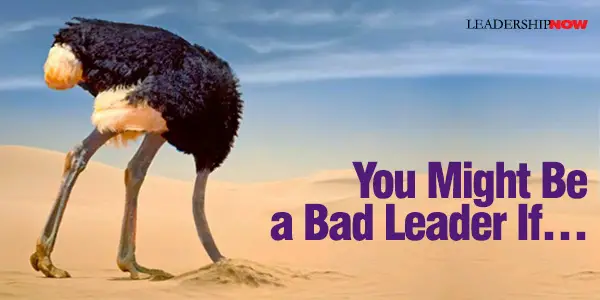
NONE OF US would readily admit to being a bad leader. We see ourselves as pretty good or at least well-intentioned. But people don’t experience our intentions; they experience what we actually do. When we struggle to get along with others or simply get things done, we would be wise to look at our assumptions and behaviors. Even just focusing on improving in one area can do wonders for your leadership and have a huge impact on those who follow you. No matter how good we are as leaders, we all do a little harm along the way. So it’s good to look at the ways bad leadership shows up so we can minimize the bad and amplify good leadership. You might be a bad leader if you are motivated by power and status. This motivation invariably leads to corruption and unethical behavior. It’s most often why otherwise effective leaders go bad. It opens the door for every other kind of mindset we associate with bad leaders. Our leadership must be about something bigger than us. Power is something to be shared. You might be a bad leader if you are easily overwhelmed. It is the nature of leadership to function in uncertainty. What makes it possible is a clarity of purpose about why we are doing what we are doing. Leaders must continuously communicate that purpose to lead others an often volatile, uncertain, complex, and ambiguous world. You might be a bad leader if you are too rigid. This is a failure to stay relevant. Staying the course is admirable, but a leader must know the times they are in. They must be effective in their current reality. Barbara Tuchman noted that a bad leader is not “deflected by the facts.” You might be a bad leader if you lack self-control. Leaders are not a superset of human beings. Leaders have impulses, desires, and needs, just like everyone else, but when we fail to control our impulses, we most often get in our own way and derail our leadership. We lose credibility as followers expect—and rightly so—leaders to put the needs of the group above their own. Of course, there are impulses that are merely a distraction for others, and then there are impulses that destroy us and hurt those around us. We must exhibit self-control for the sake of ourselves and others. Leaders who lack self-control take themselves down. You might be a bad leader if you think the ends justify the means. By crossing one too many lines, we put ourselves on the road to unethical and even evil behavior. This failure of leadership is based in self-interest. It’s self-serving. Leaders are rightfully judged by their results but not at any cost. This toxic mindset is most often gradual, and when tolerated in an organization it begins to infect all decisions and diminishes everyone involved. You might be a bad leader if you lead by fear. This kind of leader exerts a high degree of control. It also leads to incompetency as the organization can never rise above the leader themselves. In the end, the whole organization is incompetent. Good leaders must know what they don’t know. As Dirty Harry said, “A man’s got to know his limitations.” You might be a bad leader if you have a lack of respect for others—for just being people. A lack of respect manifests itself in being unkind, dismissive of the opinions and needs of others, controlling others, or showing partiality because of status or importance. We respect others when we are curious about them and listen to them. You might be a bad leader if you fail to see beyond ourselves. As leaders, we are responsible not only to the people we lead but to all of those affected by our leadership. It is a failure to do the right thing—to not do right when it is in our power to do right. You might be a bad leader if you lack the competency for our job. This doesn’t mean stupid. It’s about skills. Do we have to skills to move forward in the areas we have been tasked to lead? You might be a bad leader if you lack emotional intelligence. Leaders must be aware and sensitive to others and importantly, how their leadership is experienced by others. This implies the need for honest and candid feedback and daily reflection. Our ego creates blind spots, so we must always keep our ego in check. This is where humility comes in. A good leader leads themselves first. We must be able to recognize the signs of bad leadership so we can deal with it before it undermines us. These mindsets come up time and time again because they are common to humankind. We can’t change that. None of us are immune. Sticking our heads in the sand won’t help. Only by recognizing them when we see them in our own leadership we can effectively deal with them.
Posted by Michael McKinney at 03:32 PM
03.08.19

Lessons in Leadership to Last a Lifetime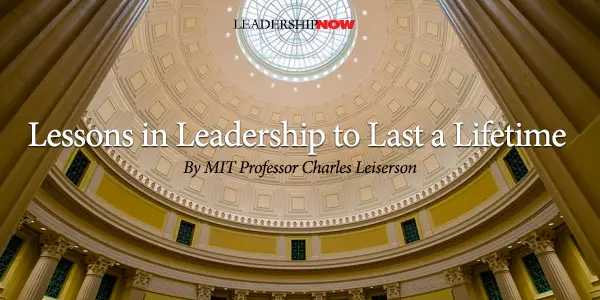
AFTER 18 YEARS on the MIT faculty, I thought I knew a thing or two about leadership. After all, I was tenured and had supervised dozens of students seeking undergraduate and postgraduate degrees. But in 1999, at the height of the Internet boom, I took a two-year leave of absence to serve as director of system architecture at Akamai Technologies, an MIT start-up located here in Cambridge. That position humbled me and taught me lessons about leadership that I still use today, some 20 years later. Back then, the vast majority of Akamai’s 100 engineering staff had been recruited directly from MIT and other top universities. Like me, most had only worked in academia up to that point, and we assumed our corporate roles and responsibilities with anticipation and a healthy dose of swagger. What could possibly stop this juggernaut of collective brilliance? Well, one collective deficit could, and did: The lack of effective leadership. You see, despite their immense talent, our teams were completely dysfunctional. Within weeks, people started to feel disgruntled, and then even worse—angry, jealous, vindictive. Morale sunk, and our productivity did, too. Fortunately, Akamai’s VP of Human Resources, Steve Heinrich, recognized what was happening and brought in Chuck McVinney, a management consultant with expertise in teamwork and leadership training. Chuck began teaching the engineering leaders about topics we had never been exposed to before: situational leadership, dealing with diversity and conflict, providing effective feedback, fostering creativity, and how to build a motivated team that leverages individual talents. Remarkably, after only two off-site workshops, our teams started to function better. We were able to focus and work collaboratively toward our goals. The workshop content wasn’t complicated, but if you’re currently running a research lab, odds are, you’ve never seen it. That’s because academia and other research organizations rarely offer leadership and management training—and as a result, far too many engineers and scientists waste their time and resources dealing with unproductive interpersonal issues and unnecessary conflict. To help right that wrong, here are five the most important lessons I learned while at Akamai, all of which I continue to use in my lab today: Research is a human endeavor
Know thyself
Mental diversity strengthens teams
Communication is key—and it involves effort
To keep leading, keep learning
It’s been about 20 years since I returned to MIT from Akamai, and businesses now routinely spend billions of dollars per year teaching employees “soft” leadership skills like the ones I just listed. If universities and other research organizations would invest even a fraction of that, their labs would be a more enjoyable place to work and their teams would be more creative and productive. 
Posted by Michael McKinney at 12:04 AM
03.06.19

35 Leadership Quotes from the 10th Global Peter Drucker Forum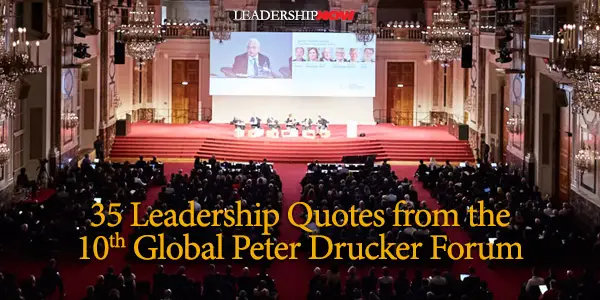
THE 10th annual Global Peter Drucker Forum was held in November 2018 in Drucker's home town of Vienna, Austria. This year’s theme was Management: The Human Dimension. The following are 35 quotes from the two-day event that are worth reflecting on: ► Innovation doesn’t happen by one person having an aha moment. —Linda Hill, Harvard Business School
► It is the age of the employees. Trust them and they will create magic. —Vineet Nayar, Sampark Foundation
► The most important person is not the CEO, but the person facing a challenge. —Isaac Getz, ESCP Europe Business School
► You can consume time or you can harvest time. When you meet people you harvest time. —Charles Édouard Bouée, Roland Berger
► You can outsource your work, but you cannot outsource your responsibility. —Paul Polman, Unilever
► We need to stay in touch with people. Go out to society and find out what are the feelings of people towards your business. —Isabelle Kocher, Engie
► Executives need to get out of the building and get into the streets where the hustle is. Leadership should shift from hierarchy to hustle. —Rosabeth Moss Kanter, Harvard Business School
► Move to the next step. Try some new things and get out of the robotic way. Try getting a little foolish. —Herminia Ibarra, London Business School
► CEOs should spend some time on a retreat and reflect, read Plato, think more of philosophy. —Adrian Wooldridge, The Economist
► We must be careful that our humanity is not swamped by the digital revolution. —Charles Handy, Social Philosopher
► We spend a lot of time with leaders telling them what to do, but we don’t tell them what to stop. —Marshall Goldsmith, Business Educator & Executive Coach
► A leader today is someone who creates an environment that other people choose to join and do their best in. —Tamara Erickson, London Business School
► Think of yourself as an artist. It gives you the ability to love, learn and lose it! We need a story that moves us and a space that holds us. —Gianpiero Petriglieri, INSEAD
► Today, businesses are in permanent crisis mode. The CEO needs to take up the leadership challenge to help others respond to that. —Constantijn Van Oranje, Special Envoy Startup Delta
► Management has maybe become too machine smitten. —Julia Kirby, Senior Editor, Harvard University Press
► Many managers mix up formulating a strategy and developing a plan. —Tim Brown, President and CEO, IDEO
► Busyness means that you are not in control of your time. —Dorie Clark, Adjunct Professor Duke University
► Capitalism is on the way to destroying itself unless it starts taking responsibility for its effect on society. —Philip Kotler, Professor, Kellogg School of Management
► Activism is good if it fits your company’s values. Otherwise: Keep your ego under control. —Peter Oswald, CEO, Mondi Group
► It’s not about fixing capitalism. It’s about fixing society. —Henry Mintzberg, Professor, McGill University
► If you push solutions onto a problem effects may be temporary and short-lived. The power of pull uses internal capabilities and create long-lasting impact. —Efosa Ojomo, Research Fellow, Clayton Christensen Institute
► Leadership is a distributed capability throughout the organization. —David Ulrich, Professor, University of Michigan
► The three keys of successful transformation are leadership, talent and culture. Talent works at the speed of culture. —Renata Lerch, VP, Scrum Alliance
► If you want to create a movement, you need two things: a sense of ownership and a sense of community. —Ricardo Vargas, Executive Director, Brightline Initiative
► Institutions change when we change. When we trade resignation for indignation. —Gary Hamel, Consultant and Professor London Business School
► Companies and workers win from fundamentally redefining work: for the first time workers are doing work that human beings should be doing. —John Hagel, Co-Chairman Deloitte Center for the Edge
► Define a purpose and then create the culture that drives that purpose. —Paul Kasimu, Director of Resources, Safaricom
► Productivity and efficiency are challenges of the 20th century. Iconic companies of the future move on to the next challenge now: Mobilizing intelligence. Basically: Thinking! —Tammy Erickson, Adjunct Professor, London Business School
► You can hire great people and turn them into mediocre or extraordinary performers. It depends on the choices leaders make and the eco-systems they create. —Professor Bill Fischer, Professor of Innovation Management IMD
► If you want better performance: 1. Adopt mindfulness; 2. Get enough sleep; 3. Stop multi-tasking. —Rasmus Hougaard, Managing Director, Potential Project
► The great question of our age is: How do we rebuild trust in the state, trust in authority? —Andrew Keen, Entrepreneur and Author
► What could be a more human endeavor than management? And yet we often approach it with an engineering mindset. —Julia Kirby, Senior Editor, Harvard University Press
► Power is not given to you by hierarchy. Power is yours when you take the initiative. —Xavier Huillard, Chairman and CEO, VINCI Group
► You don’t get innovation without diversity and conflict. —Linda Hill, Professor Harvard Business School
► Surely there are things that can’t be measured; that can’t be digitized. At my best I have imagination and vision. I have dreams. I have hope. I have trust and empathy. I have commitment. I have possibilities. I have all these things that make me interesting. That make life worth living. And work worth doing. So aren’t we lucky that these can’t be measured because otherwise if the organization were purely digitized, purely went through numbers, it would be a very dreary place—a prison for the human soul. —Charles Handy, Social Philosopher
Posted by Michael McKinney at 07:23 AM
03.04.19

11 Shifts Every Leader Needs to Make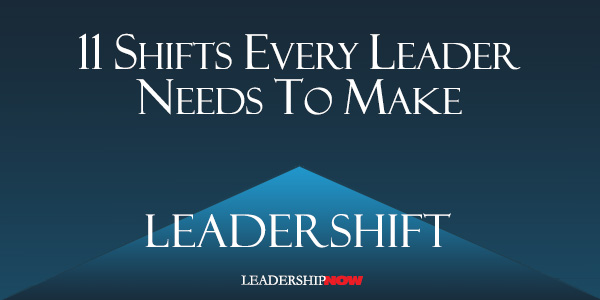
TO GET FROM where we are to where we want to be requires a shift in our thinking. When our thinking shifts in an area, our perspective changes, and new opportunities become visible. We serve people differently. In Leadershift, John Maxwell states, “every advance you make as a leader will require a Leadershift that changes the way you think, act, and lead.” Shifts in thinking require that you see a bigger picture, rethink your perspective, and understand your context. Your leadership potential depends on these shifts. It’s is unlikely that you would make all of these shifts at once. Some will happen gradually. Some will happen almost overnight. Some will come naturally to you and others will seem counterintuitive. We’re all different but we all need to make these shifts. Essentially they all boil down to making the shift from me to we. Maxwell suggests eleven leadershifts that have helped him grow as a leader. Here are a few ideas from each of the leadershifts he describes: Leadershift #1 Soloist to Conductor – The Focus Shift You can’t do it alone. Leadership is not a solo practice. Of course, working with others has its challenges. A big part of this shift is changing your focus from receiving to giving. Adding value every day without keeping score. “As leaders, we must stop wishing and start working. Instead of looking for the ‘secret sauce’ of success, we must start sowing seeds of success.” Leadershift #2 Goals to Growth – The Personal Development Shift Rather than focusing on goals, focus on growth. “Goals helped me do better, but growth helped me become better.” Begin on the inside. “Growth on the inside fuels growth on the outside.” You can’t do everything, so focus on four areas: attitude, developing strong relationships, your leadership, and equipping others to carry on without you. To become more growth-oriented, you need to embrace change, be teachable (humble), learn from failure, connect with other growth-minded people, believe in yourself, and understand that real wisdom is acquired and applied over time. Leadershift #3 Perks to Price – The Cost Shift Great leadership isn’t about control, the income or the corner office. It’s about sacrifice. Great leadership costs us something. American missionary Adoniram Judson is rumored to have said, “There is no success without sacrifice. If you succeed without sacrifice, it is because someone has suffered before you. If you sacrifice without success, it is because someone will succeed after you.” Great leaders go first. “What sets great leaders apart from all other leaders is this: they act before others, and they do more than others. Great leaders face their uncertainty and doubt, and they move through it to pave the way for others.” Leadershift #4 Pleasing People to Challenging People – The Relational Shift You can please some of the people some of the time, but you can’t please all of the people all of the time. But if you want the best out of people, you have to challenge them. “You have to put doing what’s right for your people and organization ahead of what feels right for you.” This means keeping your eye on the big picture. Sometimes you have to have tough conversations, but you must balance care with candor. Leadershift #5 Maintaining to Creating – The Abundance Shift Maintaining isn’t always easy, but it is the easiest mindset to slip into. It’s not about change for change sake, but it’s about “can we do better?” Create a creative environment where people gather ideas and value multiple perspectives. “Being inflexible and sticking to my plan put a lid on me and my organization.” Larry Stockstill said, “I live on the other side of ‘yes.’ That’s where I find abundance and opportunity. It’s where I become a better and bigger self. The opportunity of a lifetime must be seized within the lifetime of the opportunity. So I try to say ‘yes’ whenever I can.” Leadershift #6 Ladder Climbing to Ladder Building – The Reproduction Shift This shift is about equipping others. We being with ladder climbing (How high can I go?), then we shift to ladder holding (How high will others go with a little help?), then ladder extending (How high will others go with a lot of help?) to finally, ladder building (Can I help them build their own ladder?). “If you want learners to follow directions, you only need to provide the what. If you want them to lead others and give directions, they must also have the why.” Leadershift #7 Directing to Connecting – The Communication Shift You must learn to connect with people to be the best leader you can be. To move from directing people—talking, ready answers, your way—to connecting—listening, asking, empowering. Be a person people can trust. Lift others up. “When you interact with others as a leader, what is your mindset? Is your intention to correct them or connect with them?” Leadershift #8 Team Uniformity to Team Diversity – The Improvement Shift If everyone around you thinks like you, you need to expand your network. A diverse team will fill in gaps in knowledge, perspective, and experience. “Malcolm Forbes said diversity is the art of thinking independently together.” Leadershift #9 Positional Authority to Moral Authority – The Influence Shift Moral authority is not about position it’s about who you are. People follow moral authority before they follow positional authority. Maxwell lists four areas a leader needs to develop to have moral authority: competence, courage, consistency, and character. “Every leader who possesses moral authority has had to stand alone at some point in time. Such moments make leaders.” Leadershift #10 Trained Leaders to Transformational Leaders – The Impact Shift Maxwell believes that if you only make one shift in your leadership, this is the one because it “will bring the greatest change to your life and the lives of those around you.” Transformational leaders inspire others to become more. But that’s because they have worked to become more themselves. “If you want to see positive changes in your world, the first person you must change is you. As leaders, you and I have to be changed to bring change. We teach what we know, but we reproduce who we are.” Leadershift #11 Career to Calling – The Passion Shift This is the shift from just doing a job to do what you are gifted to do. Aristotle wrote, “Where our talents and the needs of the world cross, there lies our vocation.” Your calling is not about you. “A calling moves us from the center of everything in our world to becoming the channel through which good things come to others.” 
Posted by Michael McKinney at 10:30 AM
03.01.19

First Look: Leadership Books for March 2019Here's a look at some of the best leadership books to be released in March 2019. Don't miss out on other great new and future releases.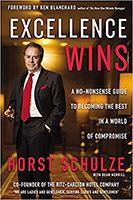 Excellence Wins: A No-Nonsense Guide to Becoming the Best in a World of Compromise Excellence Wins: A No-Nonsense Guide to Becoming the Best in a World of CompromiseHorst Schulze As the co-founder and former president of Ritz-Carlton Hotel Co., Schulze led the company to unprecedented multi-billion dollar growth, setting the business vision and people-focused standards that made the Ritz-Carlton brand globally elite. Schulze's principles are both versatile and utterly practical to leaders of every age, career stage, and industry. You don't need a powerful title or a line of direct reports—you have everything you need to use them right now. 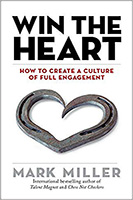 Win the Heart: How to Create a Culture of Full Engagement Win the Heart: How to Create a Culture of Full Engagement Mark Miller Employee engagement is shockingly low--but it's not an employee problem; it's a leadership problem. Bestselling author Mark Miller says it's up to leaders to create a workplace where their employees truly want to be—and he reveals four keys to doing it. 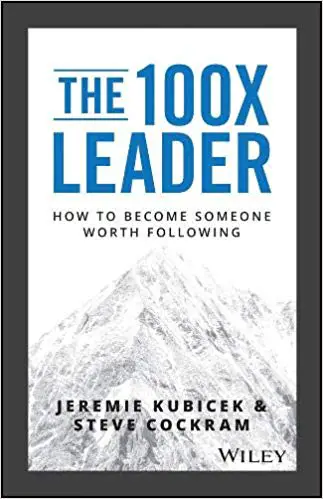 The 100X Leader: How to Become Someone Worth Following The 100X Leader: How to Become Someone Worth FollowingJeremie Kubicek and Steve Cockram The best leader you've ever had in your life was a liberator—someone willing to fight for your highest good, even at a personal cost. Inside, global leadership experts Jeremie Kubicek and Steve Cockram explain what made that leader so unique, how to become that person yourself, and how to share the same gift with others. The 100x Leader will help you become—and build—leaders worth following. 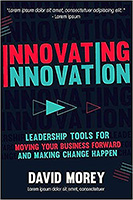 Innovating Innovation: Leadership Tools For Moving Your Business Forward and Making Change Happen Innovating Innovation: Leadership Tools For Moving Your Business Forward and Making Change HappenDavid Morey Innovation is broken. Business leaders struggle to find ways to crack through their own corporate politics or bureaucratic silos, to move from defense to offense, to nurture real breakthrough, to drive visionary creativity in ways that add new value to everything they do. Morey will guide you across 11 concrete and pragmatic steps that unlock and drive day-to-day innovation in your business and help you gain a long-term competitive advantage in your marketplace. 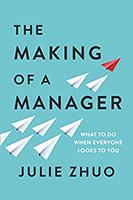 The Making of a Manager: What to Do When Everyone Looks to You The Making of a Manager: What to Do When Everyone Looks to YouJulie Zhuo Having managed dozens of teams spanning tens to hundreds of people, Julie Zhuo knows the most important lesson of all: great managers are made, not born. If you care enough to be reading this, then you care enough to be a great manager. Whether you're new to the job, a veteran leader, or looking to be promoted, this is the handbook you need to be the kind of manager you wish you had.  Build your leadership library with these specials on over 39 titles. All titles are at least 40% off the list price and are available only in limited quantities. “Books, because of the power they possess to exert intellectual influence, more so than any other form of serious communication, change the way readers — and even leaders — see the world and set the stage for them to change it.” — Peter J. Dougherty, editor-at-large at Princeton University Press
 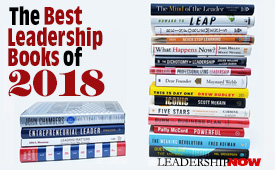
Posted by Michael McKinney at 12:28 AM
|
BUILD YOUR KNOWLEDGE


How to Do Your Start-Up Right STRAIGHT TALK FOR START-UPS 
Grow Your Leadership Skills NEW AND UPCOMING LEADERSHIP BOOKS 
Leadership Minute BITE-SIZE CONCEPTS YOU CAN CHEW ON 
Classic Leadership Books BOOKS TO READ BEFORE YOU LEAD |
|